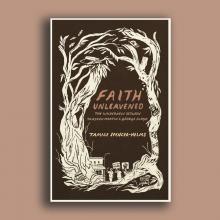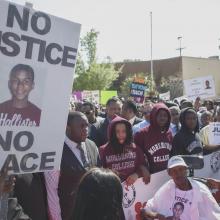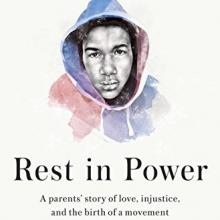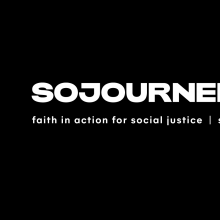Trayvon Martin
Tamice Spencer-Helms shows how colonialism and white supremacy are embodied in a Jesus made in Christian Europe's image.
BLACK LIVES MATTER. In the years since 17-year-old Trayvon Martin was murdered in his hoodie carrying Skittles, we have learned why this phrase is not simply a consequence of all lives mattering. The world systematically devalues Black life, turns Black life into death-bound life, and it is our task — as justice seekers and as Christians — to embrace Black resurrection.
Politically that makes sense, but what does it mean theologically? Surely Christianity proclaims that all might be saved, independent of skin color. A half-century ago, James Cone and fellow Black theologians embraced this theological challenge head-on. They charged that the possibility of life after death for any individual is inextricably linked to the struggle against the death-dealing forces of white supremacy. How might we fill out this insight today, with Black Power slogans themselves finding new life and new form as activists embrace Black joy, Black excellence, Black rage, Black love, and Black dignity?
In a definition that has rapidly gained traction in activist circles, Black prison abolitionist and scholar Ruth Wilson Gilmore defines racism as “the state-sanctioned or extralegal production and exploitation of group-differentiated vulnerability to premature death.” Black studies scholars have refined and deepened this claim, arguing that anti-Black racism names a system of laws, institutions, feelings, and even forms of seeing and thinking that make Black life particularly vulnerable to premature death. Slavery may have ended in the 19th century, but many of the structures and habits that made slavery possible, that made it plausible for Black human beings to be treated as less than human, persist, and those structures and habits function by making Black life precarious. One false move, and the police officer or prison guard or neighbor or privileged “Karen” may invoke the violent power of whiteness to put an early end to Black life.
IF I WERE MURDERED TODAY—say, shot and killed while walking unarmed through a residential area, wearing my hoodie—and my murderer weren’t arrested by dawn, my family would make one phone call. To Benjamin Crump.
This has become the African-American family emergency plan—set in motion when the “hurricane” is a white person with a gun. Call Benjamin Crump.
This is what Trayvon Martin’s family did in 2012 when they realized the criminal justice system would not punish the man who killed Trayvon. They called the lawyer who once stood on the steps of a courthouse where two white men had just been acquitted of beating to death a 14-year-old boy and said: “You kill a dog, you go to jail. You kill a little black boy, and nothing happens.” They called the attorney who, time and time again, tries to make something happen. They called Benjamin Crump.
In Trayvon’s case, Crump, one of the best-known civil rights attorneys practicing today, thought at first that something would happen without his help—since the only thing Martin had in his possession when George Zimmerman shot and killed him was a can of fruit juice and a bag of Skittles. When Crump realized there was a strong possibility that justice would not be served, he came face-to-face with what he calls “a test from God.”
“Nobody was watching this call between me and this brokenhearted father, save God,” Crump told Sojourners in a phone interview in October. “And I believe God was testing me to see if I was going to answer the bell, use the blessings and education and all the other things [God] has given me to be a blessing to the least of these. I stepped out on faith to do the right thing. And God took over from there.”
SEVEN YEARS AGO this month, Trayvon Martin, an unarmed 17-year-old high school student, was shot and killed while visiting relatives in Sanford, Fla. After George Zimmerman’s 2013 acquittal for Trayvon’s murder, I wrote about what it meant to me, particularly as a father.
I wrote about the fundamental injustice of a system and a nation in which a teenage boy like Trayvon could be killed as a direct result of being racially profiled, and his killer not held accountable, while my own teenage boys would never need to fear that a stranger would target them due to their race:
If my white 14-year-old son, Luke, had walked out that same night, in that same neighborhood, just to get a snack, he would have come back unharmed—and he would still be with me and Joy today. But when black 17-year-old Trayvon Martin went out that night, just to get a snack, he ended up dead—and is no longer with his dad and mom. Try to imagine how that feels, as his parents.
Martin Luther King Jr. said in his “I Have a Dream” speech, “I have a dream that my four little children will one day live in a nation where they will not be judged by the color of their skin, but by the content of their character.” King’s dream failed on Feb. 26, 2012, when George Zimmerman decided to follow Trayvon Martin because of the color of his skin. Racial profiling is a sin in the eyes of God. It should also be a crime in the eyes of our society and in the laws we enact to protect each other and our common good.

Image via Shutterstock/ Lucas Maverick Greyson
America’s allegiance is not to black and brown bodies. It is bound to prejudice, racism, militarism, and violence predominantly against people of color. And while Black Lives Matter rose as a voice and movement for black lives, the NAACP’s Youth & College Division amplified its voice, and black Americans across this nation cried out, the American majority kept quiet.
ON A SUMMER night in New York City, my husband and I enjoyed a weekend getaway. We sat atop the High Line, the elevated park along the west side of Manhattan. But our minds were a thousand miles away, in a courthouse in Florida. The George Zimmerman verdict due to come down that night was a dark cloud hanging over our date. We would finally learn if there would be justice for Trayvon. Eventually, we got our answer in the form of an iPhone news alert. George Zimmerman was acquitted.
The 2012 killing of Trayvon Martin reminded the nation that a deep racial chasm remains in the landscape of our society. The death of a 17-year-old boy carrying only Skittles and iced tea was a senseless loss. For black America, it was a sobering reminder that racism and U.S. justice are woven together so tightly that a man could shoot one of our children and be allowed to sleep in his own bed the same night.
Rest in Power: The Enduring Life of Trayvon Martin is just that, the entire story told by Trayvon’s parents Sybrina Fulton and Tracy Martin. In this raw and earnest memoir, Fulton and Martin allow us to come alongside them as they recall what they experienced in the days and months after their son was killed.

Image via Ron Frank/Shutterstock.com
It would be much easier to let the face of the tomb be a scriptural story, so we could talk about terror and grief at arm’s length. But if we strip the story of humanity, we have no recourse but to fall into Christian platitudes that have no resilience in the face of real pain and grief.

Image via Amy León Facebook
The first time I saw Amy León, she was standing in a church that was about to explode. Or had already exploded — I couldn’t tell. I was watching the music video for her song “Burning in Birmingham,” a reenactment of the 16th Street Baptist Church bombing that took the lives of four black girls on Sept. 15, 1963 in Birmingham, Ala.
The only answer to the racial divide among Christians — evangelicals in particular — is to go much deeper into what racial equity and healing will require. America’s Original Sin was written for such a time as this. It is a book written to and for white Christians and white churches — to help lead them to new conversations with black and brown Christians and their churches. It could be that studying racism in congregation after congregation, and especially between congregations across racial lines, could be a fundamental building block for genuine racial reconciliation in America.

Image via Joseph Gruber/Shutterstock.com
Stop telling me to fight. Stop saying on your social media platforms, and in your blogs and your op-eds, that everyone should dust themselves off and get up and fix this. Stop saying that addressing this issue is everyone’s duty, because I can’t even begin to explain to you how far from the truth such a statement is.
But I’ll try. I will overcome my exhaustion and explain this to you as clearly as I can, and you can thank me later, if you’re so inclined. Let it be known that I like Edible Arrangements.

Image via breakermaximus/Shutterstock.com
Millions of Americans worship the gun. Guns are used in a state of sobriety and drunkenness, by the young and old, the rich and poor — regardless of race, age, gender, or demographic. Guns are sold, traded, gifted, stolen, and smuggled — but rarely destroyed. They are kept, reused, and invested in. Many increase in value over time.
They are adored and idolized for being able to wipe away someone’s existence in a matter of seconds — which is exactly what happens. No matter what the conflict, its existence is lurking in the background — close, handy, and accessible. A source of indisputable power.
This is why many Americans — and Christians — trust more in the gun than they do in Christianity. Jesus didn’t use weapons to kill others or as a method of getting his way. Instead, Christ’s nonviolent humble love for humanity caused him to get crucified on a cross. Very un-American.
George Zimmerman, acquitted in the shooting death of Trayvon Martin on Feb. 26, 2012, now claims he will auction the gun that took Trayvon Martin’s life.
Former neighborhood watch volunteer Zimmerman listed the weapon at gunbroker.com, promoting the sale as "your opportunity to own a piece of American history."
1. Trayvon Martin Was Killed Four Years Ago Today
And here’s what’s happened since. Watch. Share.
2. How a Christian College Turned Against Its Gay Leader
“While Dr. Hawkins and I were scrutinized for different reasons, our stories have this in common: we urged Christians to stand with and for groups that sit at the center of political debates. And we did that as women, one black and one gay. I can only speculate about why Wheaton’s administration has been inconsistent in their treatment of different employees, but one thing is clear: fear makes public perception supremely important.”
Here’s an irony: Standing at the memorial tree and experiencing a cloud of witnesses on this February day during Black History Month did indeed strengthen our resolve to keep fighting through the tears and the pain. We were mindful that on this particular day — Feb. 18, 2016 — the family of Sandra Bland would assemble later in the afternoon at the Houston Courthouse to hear response to their appeal for justice to be meted upon the Waller County sheriff and police. Our cacophony of voices called upon the Holiest of Holies to break the yoke of evil systems in which cronyism and political agendas thrived.
Some white Americans would like to try to “fix” the systemic racism that exists in our criminal justice, educational, economic, and even our religious institutions. But in order for real change to occur, our understanding of realities like white privilege must also move beyond the institutional and into the very personal.
JIM WALLIS’s new book is so timely that he has been wishing, for months, that he could update its pages as each new headline about racism breaks in national news.
Think back to the images from last year in Murrieta, California, where buses of unaccompanied minors and women with children, all fleeing violence in Central America, were blocked by angry, screaming adults. In his column about this incident, the Christian evangelical, Jim Wallis, told of a talk he had recently given on immigration to his son’s fifth-grade class in Washington, DC–a class that was racially, ethnically, and religiously diverse.
While the Black Lives Matter movement officially started after George Zimmerman’s acquittal in the death of Trayvon Martin, the fight for true racial equality began long before then with the Civil Rights Era. Among the allies of the African American freedom activists were the Kennedy family, a large number of Jewish-Americans and notably, progressive evangelicals.
I met with a black friend for lunch about two years ago and discussed my concerns about the status of racial harmony in our community. I had my conscience aroused over the death of young Trayvon Martin and the reaction I received from my white friends in the days following the verdict acquitting George Zimmerman. I related to my black friend that the verdict was greeted by my white friends by offers of high fives and celebration. I was stunned and saddened and did not understand the glee.
Men and boys of color are 21 times more likely to be fatally shot by the police than their white counterparts. Of the 1,217 deadly police shootings that occurred from 2010-2012, men of color between the ages of 15 to 19 were killed at a rate of 31.17 per million, while the rate for white males the same age was only 1.47 per million.
This pattern is not new. It is old and repetitive. And it is sickening.









